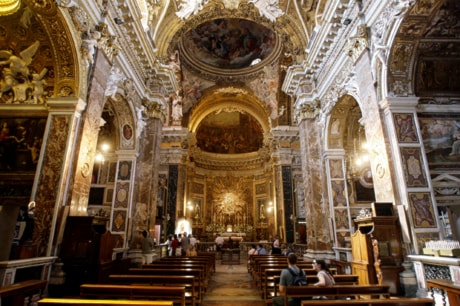ROME — On the stone steps of the 500-year-old Santa Maria del Popolo church, our tour group huddled around our guide in a tight circle.
“Come closer,” the guide said. We leaned in even more. “Be really quiet inside,” he advised. He was holding a tattered, hardcover copy of Dan Brown’s Angels & Demons, and as he spoke, he slipped it into a messenger bag slung around his shoulder.
“The priest here doesn’t like us. Oh, and don’t flash your ‘Path of Illumination’ maps.”
I felt a tingle of the forbidden as I put the yellowed map in my pocket and quietly stepped in. The church was packed with tourists and a few dozen people in the pews, waiting for Mass to begin.
A glance to my left startled me: Behind a black iron gate covering a small nook was a shroud-draped skeleton. Its head was cocked to one side and its hands crossed over the chest. Demon? Angel?
I’m not a Dan Brown fan; I casually started the blockbuster book on a recent flight to Rome from my home in Miami. But, I was intrigued. I wanted to see the sites in the novel. A few Internet clicks yielded something called “The Official Angels & Demons Rome Tour”: a four-hour romp through Rome.
I wasn’t so much taken with the plot or the controversy surrounding the book. For me, it was the setting — Rome — that was exciting. The locations in the novel were like main characters, not just backdrops to a tantalizing treasure hunt through the Eternal City. The tour, I hoped, would recreate that treasure hunt and maybe provide some real-life history along the way. It didn’t disappoint.
We met on the steps of Santa Maria del Popolo at 9:30 a.m. The nearby piazza was already bustling because the Italian state police were marking their 156th anniversary — I knew this because my husband wandered away to drool over the Police Lamborghini that transports human organs to hospitals.
Our guide greeted us and gave a brief summary of the book; the majority of us had read it, but it was fun to hear it read aloud in the crowded square. He passed out a copy of “The Path of Illumination,” a map of Rome photocopied from the novel.
After we were given the warning to be silent, we all gathered inside near the Chigi Chapel, which was designed by Raphael and filled with works by Gian Lorenzo Bernini, a 17th century sculptor — including the sculpture of a pyramid, a shape that plays a huge role in the novel.
But we couldn’t see any of it. The entire chapel was covered in white plastic and scaffolding. Same went for the “demon’s hole,” a marble, manhole-sized insert in the floor that covers a subterranean crypt. In the book, the Chigi Chapel was covered due to construction — yet unlike Professor Langdon, our tour group couldn’t pull the plastic aside to see the marble, pyramid-shaped wall tombs.
I wondered whether the rest of the sites on the tour would be off-limits too. Director Ron Howard claimed that the Vatican interfered with efforts to get permits to shoot scenes around Rome, a charge the church said was a publicity stunt on Howard’s part. Yet Rome’s diocese admitted last year it had barred producers from filming inside two churches because the movie didn’t conform to Catholic views.
At the front of the church, the priest began Mass. My husband, raised Catholic in Italy, reflexively crossed himself. I snapped a quick photo of the creepy skeleton on the way out.
From there, a bus whisked us to St. Peter’s Square. The guide discussed the fictional “mystic elements” in the book — earth, air, fire, water — then told a story about Roman Emperor Nero and St. Peter’s execution.
We spent about 45 minutes outside the Vatican (the tour is banned from entering).
Then we hustled back to the bus that took us to the rest of the stops: Santa Maria della Vittoria, the Pantheon, Piazza Navona and Castel Sant’Angelo. True to the book, Bernini’s statues of angels were everywhere. We even worked in a stop for espresso, which nearly everyone drank despite the heat of the midday Roman sun.
My favourite spot came midway through the tour, at Santa Maria della Vittoria, where Bernini’s “The Ecstasy of St. Teresa,” sculpture sits. The priest even came out and smiled at us.
